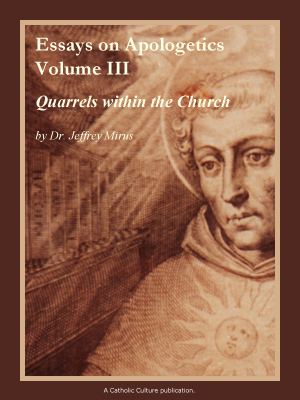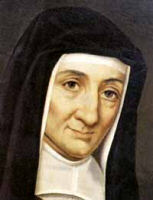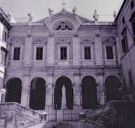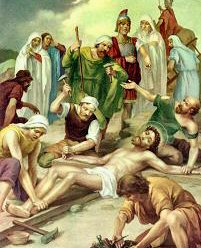Lent: March 15th
Tuesday of the Second Week of Lent
Other Commemorations: St. Louise de Marillac, Widow (RM)
Free eBook:

|
| Free eBook: Essays in Apologetics, Vol. III |
» Enjoy our Liturgical Seasons series of e-books!
Jesus’ condemnation of religious externalism, hypocrisy and vanity is not meant to correct only the Pharisees of his time. It is also directed at us. We should look into our Lenten practices of piety and works of charity and see whether they are tainted with hypocrisy. During the celebration that follows, Christ, the servant of Yahweh, will increase in us the spirit of human service.
The “phylacteries” mentioned in the gospel were bands of parchment enclosed in small boxes worn on the forehead and left fore-arm where they were fixed by straps. On these bands were inscribed the most important texts of the Law. The “fringes” were the tassels which the Law required to be worn at the four corners of the cloak. By wearing broad phylacteries and long tassels the Pharisees intended to show clearly their fidelity to the Law. —St. Andrew Missal
Today the Roman Martyrology commemorates St. Louise de Marillac. She was born in 1592, and married in 1613. When her husband died she made a vow of widowhood and devoted herself entirely to works of charity. St. Vincent de Paul, who became her spiritual director, gradually initiated her into his own charitable works for the poor and afflicted, and in 1639 they founded the Congregation of the Daughters of Charity to which St. Louise dedicated the rest of her life. She was canonized by Pope Pius XI on March 11, 1934.
Meditation—The Narrow Formalism of the Pharisees
The excessive formalism of the Pharisees led of necessity to pride. Being themselves the authors of many precepts, they believed themselves to be equally the authors of their own sanctity. They were the "separated," the pure, untouched by untying unclean. Hence what had they wherewith to reproach themselves? were they not perfectly "correct" in every way? Therefore they had the utmost esteem for themselves. Their overweening pride urged them "to love salutations in the market-place, and the first chairs in the synagogues, and the chief rooms at feasts."
The Saviour's extraordinary condescension towards publicans and sinners, rejected by them as unclean, His independence in regard to the Law of the Sabbath, for He said that He was the Lord of the Sabbath, the miracles whereby He drew the people to Him could not fail to disquiet them. the people to Him could not fail to disquiet them. the people to Him could not fail to disquiet them.
Throughout the Gospel we see them full of hatred against Jesus, striving to destroy His authority with the multitude, to turn His disciples away from Him and to deceive the people in order to hinder Him from fulfilling His mission of salvation.
—Dom Columba Marmion, Christ in His Mysteries
St. Louise de Marillac
 St. Louise de Marrillac married an official of the royal court, Antony Le Gras, and after his death in 1625 was an active supporter of the charitable work of St Vincent de Paul, who came to put more and more reliance on her. Mademoiselle Le Gras, as she was known, became the co-founder with him of the Daughters of Charity, whose 'convent is the sick-room, their chapel the parish church, their cloister the city streets'; it was she who drew up the first draft of their rule of life. Her clear intelligence and wide sympathy played a big part in the beginnings of the congregation, whose aspirants she trained and whose rapid growth involved responsibilities which largely fell on her. At the time of her death there were already over forty houses of the sisters in France, the sick poor were looked after at home in twenty-six Parisian parishes, hundreds of women were given shelter, and there were other undertakings as well. St Louise was not physically robust, but she had great powers of endurance, and her selfless devotion was a source of incalculable help and encouragement to Monsieur Vincent.
St. Louise de Marrillac married an official of the royal court, Antony Le Gras, and after his death in 1625 was an active supporter of the charitable work of St Vincent de Paul, who came to put more and more reliance on her. Mademoiselle Le Gras, as she was known, became the co-founder with him of the Daughters of Charity, whose 'convent is the sick-room, their chapel the parish church, their cloister the city streets'; it was she who drew up the first draft of their rule of life. Her clear intelligence and wide sympathy played a big part in the beginnings of the congregation, whose aspirants she trained and whose rapid growth involved responsibilities which largely fell on her. At the time of her death there were already over forty houses of the sisters in France, the sick poor were looked after at home in twenty-six Parisian parishes, hundreds of women were given shelter, and there were other undertakings as well. St Louise was not physically robust, but she had great powers of endurance, and her selfless devotion was a source of incalculable help and encouragement to Monsieur Vincent.
—Dictionary of Saints by Donald Attwater.
Patronage: disappointing children; loss of parents; people rejected by religious orders; sick people; Christian Social Workers (proclaimed on 12 February 1960 by Pope John XXIII); Vincentian Service Corps; widows
Symbols and Representation: widows' clothing; Saint Louise is depicted wearing the original Vincentian habit of grey wool with a large headdress of white linen (typical of poor women in 17th century Brittany), perhaps with an infant in her arms.
Highlights and Things to Do:
- Read more about St. Louise:
- Teach your children this simple morning aspiration by St. Louise: "Grant me the grace to spend this day without offending You and without failing my neighbor."
- Daughters of Charity of St. Vincent de Paul which she helped found.
- St. Louise's remains are enshrined in the Chapel of the Miraculous Medal in the motherhouse of the Daughters of Charity in Paris. Her body is not incorrupt, but rather the body in the chapel is actually a wax effigy, containing her bones.
- Begin planning a family Passion presentation or play in which all can participate. You may want to plan this for the end of Lent — Spy Wednesday or Holy Thursday would be particularly appropriate days for this.

Friday of the Fourth Week of Lent
Station with Sant'Eusebio all'Esquilino (St. Eusebius in Esquiline):
Ancient church dedicated to St Eusebius of Vercelli, 4th century bishop. The church was financed by St. Eusebius of Bologna, and is first mentioned in 474. This means that it's one of the oldest churches in Rome; it was one of the first parish churches known as the Titulus Eusebi.
For more on Sant'Eusebio all'Esquilino, see:
For further information on the Station Churches, see The Stational Church.







